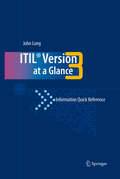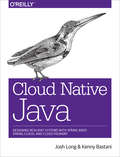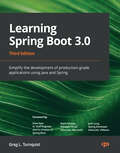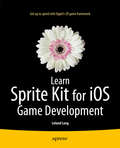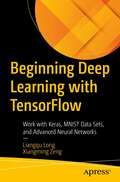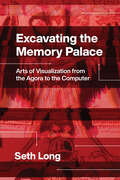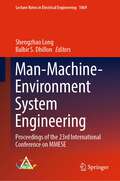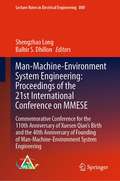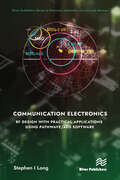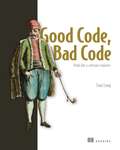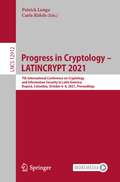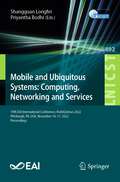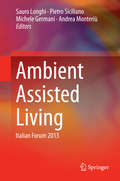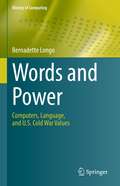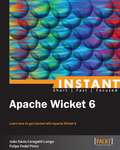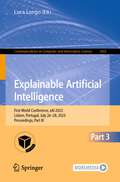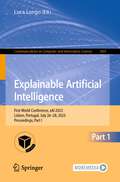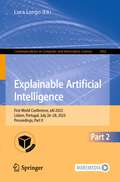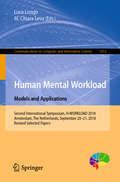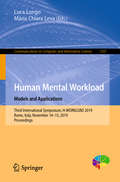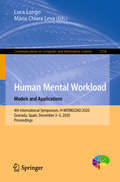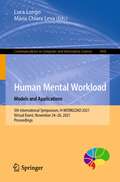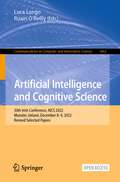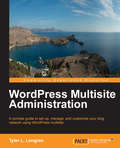- Table View
- List View
ITIL Version 3 at a Glance
by John O. LongITIL® Version 3 At a Glance takes a graphical approach to consolidating the information of ITIL® version 3. ITIL® is an internationally-recognized set of best practices for providing IT service management. IT organizations worldwide are implementing ITIL® as a vehicle for improving IT service quality and improve return on investment for IT services. The desk reference's unique graphical approach takes otherwise complex textual descriptions and makes the information accessible in a series of consistent, simple diagrams. ITIL® Version 3 At a Glance will be of interest to organizations looking to train their staffs in a consistent and cost-effective way. Further, this book is ideal for anyone involved in planning consulting, implementing, or testing an ITIL® Version 3 implementation.
Cloud Native Java: Designing Resilient Systems with Spring Boot, Spring Cloud, and Cloud Foundry
by Josh Long Kenny BastaniLearn the essentials of the Spring Boot microframework for developing modern, cloud-ready JVM applications and microservices across a variety of environments. With this practical book, you’ll learn everything you need to know to get started working with Spring Boot.A modern cloud-native architecture looks very different from the architectures inspired by the economics of scale ten years ago. Now that the cloud is the default for everyone—and not just trailblazers like Google, Amazon, Twitter, and Netflix—Spring Boot and Spring Cloud offer the best tools to commoditize the architecture of the cloud. This book shows you how to leverage Spring Boot to build modular, highly-scalable applications.
Learning Spring Boot 3.0: Simplify the development of production-grade applications using Java and Spring, 3rd Edition
by Josh Long Greg L. Turnquist Mark Heckler Dave SyerBuild Java web apps without wasting any time with this third edition of the best-selling Spring Boot guide for beginners, updated and enhanced with defining features of Spring Boot 3Purchase of the print or Kindle book includes a free eBook PDFKey FeaturesLearn Spring Boot in a cohesive manner with this practical guide by a core Spring contributorDiscover popular Java developer tools such as GraalVM native images, serving up JSON, and moreBuild secure, scalable, and manageable web applications from zero to productionBook DescriptionSpring Boot 3 brings more than just the powerful ability to build secure web apps on top of a rock-solid database. It delivers new options for testing, deployment, Docker support, and native images for GraalVM, along with ways to squeeze out more efficient usage of existing resources.This third edition of the bestseller starts off by helping you build a simple app, and then shows you how to secure, test, bundle, and deploy it to production. Next, you'll familiarize yourself with the ability to go “native” and release using GraalVM. As you advance, you'll explore reactive programming and get a taste of scalable web controllers and data operations. The book goes into detail about GraalVM native images and deployment, teaching you how to secure your application using both routes and method-based rules and enabling you to apply the lessons you've learned to any problem. If you want to gain a thorough understanding of building robust applications using the core functionality of Spring Boot, then this is the book for you.By the end of this Spring Boot book, you'll be able to build an entire suite of web applications using Spring Boot and deploy them to any platform you need.What you will learnCreate powerful, production-grade web applications with minimal fussSupport multiple environments with one artifact, and add production-grade support with featuresFind out how to tweak your Java apps through different propertiesEnhance the security model of your appsMake use of enhancing features such as native deployment and reactive programming in Spring BootBuild anything from lightweight unit tests to fully running embedded web container integration testsGet a glimpse of reactive programming and decide if it's the right approach for youWho this book is forThis book is for both novices and experienced Spring developers looking to learn how to build applications without wasting time on infrastructure and other tedious details. Working knowledge of the Java programming language is assumed.
Learn Sprite Kit for iOS Game Development
by Leland LongWith Learn Sprite Kit for iOS Game Development, you'll discover how easy it is to create 2D games using the new Sprite Kit framework from Apple. You'll find how simple it is to create a scene, add animated sprites, incorporate edges, play sound effects, and create animated particles for special effects. You'll also use touch events to control your sprites, implement the built-in physics engine, handle sprite collisions and contacts, and much more. To help you in learning how to use all these cool features of Sprite Kit, you'll follow along as we build a complete 2D game for iPhone. By the time you finish the book, you'll have made your own 2D game, and you'll have learned all you need to know to get started on your next masterpiece. What you'll learn How to add animated sprites to your game scene Using TouchEvents to have your sprite react to touch input How to apply realistic physics to your game scene and characters Handling sprite collisions and contacts with other game elements Adding game logic for sprite interaction, scoring, levels, and more Adding a second player and using GameKit Who this book is for Beginning developers who have some understanding of object-oriented programming as well as intermediate iOS developers who want to get up to speed quickly with Sprite Kit. Table of Contents 1. Hello World 2. SKActions and SKTexture: Your First Animated Sprite 3. Sprite Movement with User Input 4. Edges, Boundaries, and Ledges 5. More Animated Sprites: Enemies and Bonuses 6. Creating a Cast of Characters 7. Points and Scoring 8. Contacts and Collisions 9. Adding More Scenes and Levels 10. Where to Go from Here
Beginning Deep Learning with TensorFlow: Work with Keras, MNIST Data Sets, and Advanced Neural Networks
by Liangqu Long Xiangming ZengIncorporate deep learning into your development projects through hands-on coding and the latest versions of deep learning software, such as TensorFlow 2 and Keras. The materials used in this book are based on years of successful online education experience and feedback from thousands of online learners. You’ll start with an introduction to AI, where you’ll learn the history of neural networks and what sets deep learning apart from other varieties of machine learning. Discovery the variety of deep learning frameworks and set-up a deep learning development environment. Next, you’ll jump into simple classification programs for hand-writing analysis. Once you’ve tackled the basics of deep learning, you move on to TensorFlow 2 specifically. Find out what exactly a Tensor is and how to work with MNIST datasets. Finally, you’ll get into the heavy lifting of programming neural networks and working with a wide variety of neural network types such as GANs and RNNs. Deep Learning is a new area of Machine Learning research widely used in popular applications, such as voice assistant and self-driving cars. Work through the hands-on material in this book and become a TensorFlow programmer! What You'll LearnDevelop using deep learning algorithmsBuild deep learning models using TensorFlow 2Create classification systems and other, practical deep learning applicationsWho This Book Is ForStudents, programmers, and researchers with no experience in deep learning who want to build up their basic skillsets. Experienced machine learning programmers and engineers might also find value in updating their skills.
Excavating the Memory Palace: Arts of Visualization from the Agora to the Computer
by Seth LongWith the prevalence of smartphones, massive data storage, and search engines, we might think of today as the height of the information age. In reality, every era has faced its own challenges of storing, organizing, and accessing information. While they lacked digital devices, our ancestors, when faced with information overload, utilized some of the same techniques that underlie our modern interfaces: they visualized and spatialized data, tying it to the emotional and sensory spaces of memory, thereby turning their minds into a visual interface for accessing information. In Excavating the Memory Palace, Seth David Long mines the history of Europe’s arts of memory to find the origins of today’s data visualizations, unearthing how ancient constructions of cognitive pathways paved the way for modern technological interfaces. Looking to techniques like the memory palace, he finds the ways that information has been tied to sensory and visual experience, turning raw data into lucid knowledge. From the icons of smart phone screens to massive network graphs, Long shows us the ancestry of the cyberscape and unveils the history of memory as a creative act.
Man-Machine-Environment System Engineering: Proceedings of the 23rd International Conference on MMESE (Lecture Notes in Electrical Engineering #1069)
by Shengzhao Long Balbir S. DhillonMan-Machine-Environment System Engineering: Proceedings of the 23rd Conference on MMESE are an academic showcase of the best papers selected from more than 500 submissions, introducing readers to the top research topics and the latest developmental trends in the theory and application of MMESE. This proceedings are interdisciplinary studies on the concepts and methods of physiology, psychology, system engineering, computer science, environment science, management, education, and other related disciplines. Researchers and professionals who study an interdisciplinary subject crossing above disciplines or researchers on MMESE subject will be mainly benefited from this proceedings.MMESE primarily focuses on the relationship between Man, Machine and Environment, studying the optimum combination of man-machine-environment systems. In this system, “Man” refers to working people as the subject in the workplace (e.g. operators, decision-makers); “Machine” is the general name for any object controlled by Man (including tools, machinery, computers, systems and technologies), and “Environment” describes the specific working conditions under which Man and Machine interact (e.g. temperature, noise, vibration, hazardous gases etc.). The three goals of optimization of the man-machine-environment systems are to ensure safety, efficiency and economy.The integrated and advanced science research topic Man-Machine-Environment System Engineering (MMESE) was first established in China by Professor Shengzhao Long in 1981, with direct support from one of the greatest modern Chinese scientists, Xuesen Qian. In a letter to Shengzhao Long from October 22nd, 1993, Xuesen Qian wrote: “You have created a very important modern science and technology in China!”
Man-Machine-Environment System Engineering: Commemorative Conference for the 110th Anniversary of Xuesen Qian’s Birth and the 40th Anniversary of Founding of Man-Machine-Environment System Engineering (Lecture Notes in Electrical Engineering #800)
by Shengzhao Long Balbir S. DhillonMan-Machine-Environment System Engineering: Proceedings of the 21st Conference on MMESE is the academic showcase of best research papers selected from more than 500 submissions each year. From this book reader will learn the best research topics and the latest development trend in MMESE design theory and other human-centered system application.MMESE focus mainly on the relationship between Man, Machine and Environment. It studies the optimum combination of man-machine-environment systems. In the system, the Man means the working people as the subject in the workplace (e.g. operator, decision-maker); the Machine means the general name of any object controlled by the Man (including tool, Machinery, Computer, system and technology), the Environment means the specially working conditions under which Man and Machine occupy together(e.g. temperature, noise, vibration, hazardous gases etc.). The three goals of the optimization of the system are safety, efficiency and economy.In 1981 with direct support from one of the greatest modern Chinese scientists, Qian Xuesen, Man-Machine-Environment System Engineering (MMESE), the integrated and advanced science research topic was established in China by Professor Shengzhao Long. In the letter to Shengzhao Long, in October 22nd, 1993, Qian Xuesen wrote: “You have created a very important modern science subject and technology in China!”.
Communication Electronics: RF Design with Practical Applications using Pathwave/ADS Software (River Publishers Series in Electronic Materials, Circuits and Devices)
by Stephen I LongThis text/reference develops practical intuition into the art of RF circuit design and introduces users to the widely used simulation tool, Pathwave ADS, from Keysight Technologies. By using project-oriented assignments, it builds a strong foundation and focuses on practical applications illustrated by examples, simulation tutorials, and homework problems. Learning through doing has proven to be an effective preparatory tool for more advanced and complex applications, and this book is developed from the author’s lecture notes for a senior/graduate class at University of California Santa Barbara. The class had a significant lab component employing measurement techniques, board-level prototyping, and RFIC design. Falling somewhere between a traditional textbook and a practical handbook, it focuses mainly on analog RF analysis and design and circuit simulation techniques.
Good Code, Bad Code: Think like a software engineer
by Tom LongPractical techniques for writing code that is robust, reliable, and easy for team members to understand and adapt.Summary In Good Code, Bad Code you&’ll learn how to: Think about code like an effective software engineer Write functions that read like well-structured sentences Ensure code is reliable and bug free Effectively unit test code Identify code that can cause problems and improve it Write code that is reusable and adaptable to new requirements Improve your medium and long-term productivity Save yourself and your team time The difference between good code or bad code often comes down to how you apply the established practices of the software development community. In Good Code, Bad Code you&’ll learn how to boost your productivity and effectiveness with code development insights normally only learned through careful mentorship and hundreds of code reviews. Purchase of the print book includes a free eBook in PDF, Kindle, and ePub formats from Manning Publications. About the technology Software development is a team sport. For an application to succeed, your code needs to be robust and easy for others to understand, maintain, and adapt. Whether you&’re working on an enterprise team, contributing to an open source project, or bootstrapping a startup, it pays to know the difference between good code and bad code. About the book Good Code, Bad Code is a clear, practical introduction to writing code that&’s a snap to read, apply, and remember. With dozens of instantly-useful techniques, you&’ll find coding insights that normally take years of experience to master. In this fast-paced guide, Google software engineer Tom Long teaches you a host of rules to apply, along with advice on when to break them! What's inside Write functions that read like sentences Ensure your code stays bug-free How to sniff out bad code Save time for yourself and your team About the reader For coders early in their careers who are familiar with an object-oriented language, such as Java or C#. About the author Tom Long is a software engineer at Google where he works as a tech lead. Among other tasks, he regularly mentors new software engineers in professional coding best practices. Table of Contents PART 1 IN THEORY 1 Code quality 2 Layers of abstraction 3 Other engineers and code contracts 4 Errors PART 2 IN PRACTICE 5 Make code readable 6 Avoid surprises 7 Make code hard to misuse 8 Make code modular 9 Make code reusable and generalizable PART 3 UNIT TESTING 10 Unit testing principles 11 Unit testing practices
Progress in Cryptology – LATINCRYPT 2021: 7th International Conference on Cryptology and Information Security in Latin America, Bogotá, Colombia, October 6–8, 2021, Proceedings (Lecture Notes in Computer Science #12912)
by Patrick Longa Carla RàfolsThis book constitutes the proceedings of the 7th International Conference on Cryptology and Information Security in Latin America, LATIN 2021, which was held in October 2021. The conference was originally planned to take place in Bogota, Colombia, but changed to a virtual event due to the COVID-19 pandemic. The 22 full papers included in this volume were carefully reviewed and selected from 47 submissions. They were organized in topical sections as follows: quantum cryptography; post-quantum cryptography; asymmetric cryptanalysis; cryptanalysis and side-channel analysis; distributed cryptographic protocols; and multiparty computation.
Mobile and Ubiquitous Systems: 19th EAI International Conference, MobiQuitous 2022, Pittsburgh, PA, USA, November 14-17, 2022, Proceedings (Lecture Notes of the Institute for Computer Sciences, Social Informatics and Telecommunications Engineering #492)
by Shangguan Longfei Priyantha BodhiThis book constitutes the refereed post-conference proceedings of the 19th International Conference on Mobile and Ubiquitous Systems: Computing, Networking and Services, MobiQuitous 2022, which was held in Pittsburgh, November 14-17, 2022. The conference was held virtually due to the COVID-19 pandemic.The 26 full and 2 short papers were carefully reviewed and selected from 95 submissions and present discussions, They were organized in topical sections as follows: Internet of Things (IoT), Security and Privacy, Human-centric sensing, Drone applications and edge computing, Wireless networks, Mobile and human computer interactions, Poster and demo sessions, Technology for health
Ambient Assisted Living: Italian Forum 2013 (Lecture Notes in Electrical Engineering #11)
by Sauro Longhi Pietro Siciliano Michele Germani Andrea MonteriùThis book presents the refereed proceedings of the Fourth Italian Forum on Ambient Assisted Living (AAL), held in Ancona, Italy, in October 2013. A wide range of issues are covered and new technological developments are described which will support the autonomy and independence of individuals with special needs through an innovative and integrated approach, designed to respond to the socio-economic challenges of an aging population. Topics addressed include: health and well-being, prevention and rehabilitation and support for care providers; active aging and its social implications; services for the frail elderly with health problems and their families; nutrition; ICT platforms/technologies for the benefit of the elderly; home automation and control technologies (autonomy, safety and energy saving); smart cities and smart communities; telemedicine, telerehabilitation, and telecare; mobility, participation and social inclusion; games and fun for the elderly; building design; social housing; interface design and interaction (accessibility, acceptance); social policies to encourage and support active aging; business models, market analysis and development of sustainable financing and business and ethics, privacy and data protection. Many experimental validations based on user trials and usability testing are presented and discussed. The knowledge and insights provided in this book will help researchers and others involved in AAL to understand relevant societal trends, novel technological developments and pressing challenges.
Words and Power: Computers, Language, and U.S. Cold War Values (History of Computing)
by Bernadette LongoWhen viewed through a political lens, the act of defining terms in natural language arguably transforms knowledge into values. This unique volume explores how corporate, military, academic, and professional values shaped efforts to define computer terminology and establish an information engineering profession as a precursor to what would become computer science. As the Cold War heated up, U.S. federal agencies increasingly funded university researchers and labs to develop technologies, like the computer, that would ensure that the U.S. maintained economic prosperity and military dominance over the Soviet Union. At the same time, private corporations saw opportunities for partnering with university labs and military agencies to generate profits as they strengthened their business positions in civilian sectors. They needed a common vocabulary and principles of streamlined communication to underpin the technology development that would ensure national prosperity and military dominance. investigates how language standardization contributed to the professionalization of computer science as separate from mathematics, electrical engineering, and physicsexamines traditions of language standardization in earlier eras of rapid technology development around electricity and radiohighlights the importance of the analogy of “the computer is like a human” to early explanations of computer design and logictraces design and development of electronic computers within political and economic contextsforegrounds the importance of human relationships in decisions about computer designThis in-depth humanistic study argues for the importance of natural language in shaping what people come to think of as possible and impossible relationships between computers and humans. The work is a key reference in the history of technology and serves as a source textbook on the human-level history of computing. In addition, it addresses those with interests in sociolinguistic questions around technology studies, as well as technology development at the nexus of politics, business, and human relations.
Instant Apache Wicket 6
by Joao Savio Longo Felipe Fedel PintoGet to grips with a new technology, understand what it is and what it can do for you, and then get to work with the most important features and tasks. This Starter style guide takes the reader through the basic workflow of Apache Wicket in a practical and friendly style.Instant Apache Wicket 6 is for people who want to learn the basics of Apache Wicket 6 and who already have some experience with Java and object-oriented programming. Basic knowledge of web concepts like HTTP and Ajax will be an added advantage.
Explainable Artificial Intelligence: First World Conference, xAI 2023, Lisbon, Portugal, July 26–28, 2023, Proceedings, Part III (Communications in Computer and Information Science #1903)
by Luca LongoThis three-volume set constitutes the refereed proceedings of the First World Conference on Explainable Artificial Intelligence, xAI 2023, held in Lisbon, Portugal, in July 2023. The 94 papers presented were thoroughly reviewed and selected from the 220 qualified submissions. They are organized in the following topical sections: Part I: Interdisciplinary perspectives, approaches and strategies for xAI; Model-agnostic explanations, methods and techniques for xAI, Causality and Explainable AI; Explainable AI in Finance, cybersecurity, health-care and biomedicine.Part II: Surveys, benchmarks, visual representations and applications for xAI; xAI for decision-making and human-AI collaboration, for Machine Learning on Graphs with Ontologies and Graph Neural Networks; Actionable eXplainable AI, Semantics and explainability, and Explanations for Advice-Giving Systems.Part III: xAI for time series and Natural Language Processing; Human-centered explanations and xAI for Trustworthy and Responsible AI; Explainable and Interpretable AI with Argumentation, Representational Learning and concept extraction for xAI.
Explainable Artificial Intelligence: First World Conference, xAI 2023, Lisbon, Portugal, July 26–28, 2023, Proceedings, Part I (Communications in Computer and Information Science #1901)
by Luca LongoThis three-volume set constitutes the refereed proceedings of the First World Conference on Explainable Artificial Intelligence, xAI 2023, held in Lisbon, Portugal, in July 2023. The 94 papers presented were thoroughly reviewed and selected from the 220 qualified submissions. They are organized in the following topical sections: Part I: Interdisciplinary perspectives, approaches and strategies for xAI; Model-agnostic explanations, methods and techniques for xAI, Causality and Explainable AI; Explainable AI in Finance, cybersecurity, health-care and biomedicine.Part II: Surveys, benchmarks, visual representations and applications for xAI; xAI for decision-making and human-AI collaboration, for Machine Learning on Graphs with Ontologies and Graph Neural Networks; Actionable eXplainable AI, Semantics and explainability, and Explanations for Advice-Giving Systems.Part III: xAI for time series and Natural Language Processing; Human-centered explanations and xAI for Trustworthy and Responsible AI; Explainable and Interpretable AI with Argumentation, Representational Learning and concept extraction for xAI.
Explainable Artificial Intelligence: First World Conference, xAI 2023, Lisbon, Portugal, July 26–28, 2023, Proceedings, Part II (Communications in Computer and Information Science #1902)
by Luca LongoChapters “Finding Spurious Correlations with Function-Semantic Contrast Analysis” and “Explaining Socio-Demographic and Behavioral Patterns of Vaccination Against the Swine Flu (H1N1) Pandemic” are available open access under a Creative Commons Attribution 4.0 International License via link.springer.com.
Human Mental Workload: Second International Symposium, H-WORKLOAD 2018, Amsterdam, The Netherlands, September 20-21, 2018, Revised Selected Papers (Communications in Computer and Information Science #1012)
by Luca Longo M. Chiara LevaThis book constitutes the refereed proceedings of the Second International Symposium on Human Mental Workload: Models and Applications, H-WORKLOAD 2018, held in Amsterdam, The Netherlands, in September 2018. The 15 revised full papers presented together with one keynote were carefully reviewed and selected from 31 submissions. The papers are organized in two topical sections on models and applications.
Human Mental Workload: Third International Symposium, H-WORKLOAD 2019, Rome, Italy, November 14–15, 2019, Proceedings (Communications in Computer and Information Science #1107)
by Luca Longo Maria Chiara LevaThis book constitutes the refereed proceedings of the Third International Symposium on Human Mental Workload: Models and Applications, H-WORKLOAD 2019, held in Rome, Italy, in November 2019.The volume presents one keynote paper as well as 14 revised full papers, which were carefully reviewed and selected from 32 submissions. The papers are organized in two topical sections on models and applications.
Human Mental Workload: 4th International Symposium, H-WORKLOAD 2020, Granada, Spain, December 3–5, 2020, Proceedings (Communications in Computer and Information Science #1318)
by Luca Longo Maria Chiara LevaThis book constitutes the refereed proceedings of the 4th International Symposium on Human Mental Workload: Models and Applications, H-WORKLOAD 2020, held in Granda, Spain*, in December 2020.The volume presents one keynote paper as well as 13 revised full papers, which were carefully reviewed and selected from 22 submissions. The papers are organized in two topical sections on models and applications.*The conference was held virtually due to the COVID-19 pandemic.
Human Mental Workload: 5th International Symposium, H-WORKLOAD 2021, Virtual Event, November 24–26, 2021, Proceedings (Communications in Computer and Information Science #1493)
by Luca Longo Maria Chiara LevaThis book constitutes the refereed proceedings of the 5th International Symposium on Human Mental Workload: Models and Applications, H-WORKLOAD 2021, held virtually in November 2021.The volume presents 9 revised full papers, which were carefully reviewed and selected from 16 submissions. The papers are organized in two topical sections on models and applications.
Artificial Intelligence and Cognitive Science: 30th Irish Conference, AICS 2022, Munster, Ireland, December 8–9, 2022, Revised Selected Papers (Communications in Computer and Information Science #1662)
by Luca Longo Ruairi O’ReillyThis open access book constitutes selected papers presented during the 30th Irish Conference on Artificial Intelligence and Cognitive Science, held in Munster, Ireland, in December 2022. The 41 presented papers were thoroughly reviewed and selected from the 102 submissions. They are organized in topical sections on machine learning, deep learning and applications; responsible and trustworthy artificial intelligence; natural language processing and recommender systems; knowledge representation, reasoning, optimisation and intelligent applications.
WordPress Multisite Administration
by Tyler L. LongrenThis is a simple, concise guide with a step-by-step approach, packed with screenshots and examples to set up and manage a network blog using WordPress.WordPress Multisite Administration is ideal for anyone wanting to familiarize themselves with WordPress Multisite. You'll need to know the basics about WordPress, and having at least a broad understanding of HTML, CSS, and PHP will help, but isn't required.
Microsoft Visual J# .NET
by Andy Longshaw John Sharp Peter Roxburgh<div xmlns="http://www.w3.org/1999/xhtml"><p>Presented in an easy-to-browse format, this erudite book provides the authoritative technical details you need to leverage Microsoft Visual J# .NET and the richness of the Microsoft .NET Framework to build scalable, enterprise-level applications.</p></div>
